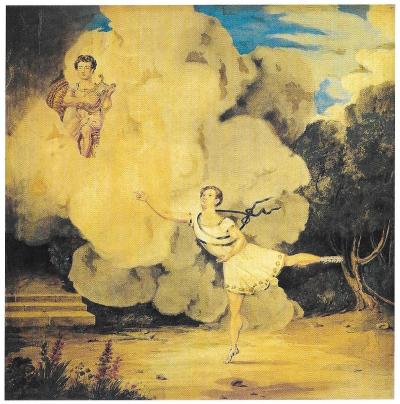In my last post about the pas de Zephyr, I suggested that there were four contenders for the professional male dancer who may have originated the step or the enchainement from which the social dance step took its name – André Deshayes, Louis Duport, Charles-Louis Didelot and Monsieur Albert. As I also said, there are a number of issues to consider as I try to answer the question of who was responsible, if the pas de Zephyr can indeed be traced to a single dancer.
There are at least six descriptions of the step in social dance manuals. Three of these are English – Payne (1818), Strathy (1822) and Mason (1827). Two are French – Gourdoux-Daux (1823) and Albert (1834). One is Italian – Costa (1831). It is interesting that there are a number of English treatises, although it seems likely that the earliest description of the pas de Zephyr is in fact French. It could have appeared in either the first treatise by Gourdoux Daux, Principes et notions élémentaires sur l’art de la danse published in 1804, or its second edition published in 1811, neither of which I have yet been able to consult. However, might the inclusion of the step in English treatises suggest that the dancer (whoever he was) also appeared as Zephyr on the London stage?
All the treatises are, of course, for amateurs and dancing in the ballroom. Apart from the fact that the stage version of the pas de Zephyr would have had to be simplified for performance by amateur dancers, there is also the question of appropriate style. Strathy devotes much space to the variations appropriate for what he calls ‘Balancer, or to Set to your Partner’ (for which his recommended steps include the pas de Zephyr). Before he does so, he emphasises the importance of a ‘gliding smoothness of execution’, however difficult the steps. Strathy also refers to ‘that easy, dignified and engaging manner, which never fails to distinguish a polite person’ and ‘the importance of a genteel and prepossessing deportment of the person’. In the early 19th-century ballroom, style was as important as technique and the latter should never undermine the former.
So, there are at least three issues to consider in identifying the dancer responsible for inspiring the addition of the pas de Zephyr to those steps deemed suitable for the ballroom. The first is the period during which each dancer appeared as Zephyr, which must allow time for the stage step to be seen, admired, transformed and adopted in the ballroom before it was recorded in treatises. The second is whether the dancer appeared in both London and Paris. The third is the dancer’s performance style and how it interacted with their virtuosity (all four dancers were highly technically accomplished).
At this point, I think it is possible to discount Didelot, at least as a performer. Although he spent much of his earlier career in London, he appeared relatively little in Paris. He was the eldest of the four dancers by some years, and so is perhaps less likely to have influenced dancing masters around 1800. In any case, his style (that of a demi-caractère dancer) would not have recommended itself to teachers of social dancing. On the other hand, he did create Zéphire et Flore – the most famous of the Zephyr ballets – which may have been a work within which the pas de Zephyr drew particular attention.
Monsieur Albert almost certainly appeared too late to be the originator of the pas de Zephyr, since he was only engaged at the Paris Opéra from 1808 and did not dance in London until the 1820s. His style was undoubtedly worth emulating, so perhaps he contributed to the continued popularity of the pas de Zephyr in the ballroom.
It seems to me that the two dancers most likely to have caught the imagination of audiences with their versions of the pas de Zephyr are André Deshayes and Louis Duport. Both were closely identified with the role of Zephyr and both appeared in London as well as Paris. Deshayes spent more time in London, whereas Duport was more famous in Paris. Deshayes was as famed for his style as his virtuosity, which made him a model for aspirant ballroom dancers. Duport allowed his legendary skill to run away with him on many occasions, which must have made his tours de force hard to forget. So, could they each have contributed towards the adoption of this step in their different ways? The watercolour in which both dancers have been separately identified underlines the difficulty of choosing between them.

Scene from Gardel’s Le Retour de Zéphire? Undated watercolour by an anonymous artist.
If I have to choose, I would settle on Deshayes – for his style as much as for his fame as Zephyr. However, perhaps what really mattered were the various Zephyr ballets, irrespective of who danced the title role. The vocabulary deployed by all four men, and indeed other dancers who played Zephyr, probably made use of a similar range of steps intended to make the danseur noble appear to fly. Who would not want to feel as if they were as elegantly airborne when dancing as one of the ballet’s great stars, even within the confines of the ballroom?





